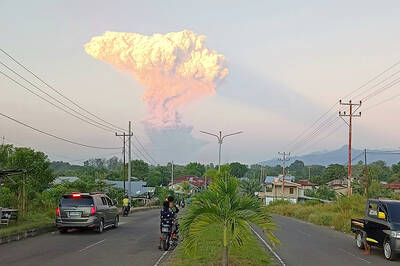Just a few kilometers after passing a towering Marlboro Man ad, a second billboard off the highway promotes cigarettes with a new American face: Kelly Clarkson.
The former American Idol winner invites fans to buy tickets to her upcoming concert in Jakarta. The logo of her sponsor is splashed in huge type above her head — the popular Indonesian cigarette brand LA Lights. Similar ads also run on TV.
Such in-your-face tobacco advertising has been banned for years in many other countries, but in Indonesia, the world’s fourth-most populous nation, tobacco companies have virtual free rein to peddle their products, from movies to sports sponsorships and television shows. The country remains one of the last holdouts that have not signed the WHO’s tobacco treaty.
Smoking has risen in Indonesia, where about 63 percent of all men light up and one-third of the overall population smokes, an increase of 26 percent since 1995. Smoking-related illnesses kill at least 200,000 annually in a nation of 235 million.
“Indonesia is a big concern, a big epidemic, a big population and very little control,” said Prabhat Jha, a tobacco control expert at the University of Toronto’s Centre for Global Health Research. “They have a chaotic taxation and regulatory structure. They have made the mistake of letting the Marlboro Man into the country.”
In recent months, anti-tobacco forces have rallied. A new health law has declared smoking addictive and urged the government to hammer out tobacco regulations. An anti-smoking coalition is pushing for tighter restrictions on smoking in public places, advertising bans and bigger health warnings on cigarette packages.
Public debate also exploded last month after Muhammadiyah, Indonesia’s second-largest Islamic organization, issued a fatwa banning smoking. Though not legally binding, the religious ruling does put pressure on smokers in the world’s most populous Muslim nation.
About a quarter of Indonesian boys aged 13 to 15 are already hooked on cigarettes that sell for about US$1 a pack, the WHO said.
Smoking is embedded in Indonesia’s culture. Wafts of a pungent mixture of tobacco and cloves, called kreteks, can be smelled in houses rich and poor across the vast archipelago.
A 2008 study on tobacco revenue in Indonesia showed that smokers spend more than 10 percent of their household income on cigarettes — three times more than they spend on education expenses such as school fees and books.
Indonesia remains one of the last places in the world where cigarette TV commercials still run, featuring rugged men and beautiful women smoking. Billboards plastered above four-lane highways encourage motorists stuck in Jakarta’s notorious traffic jams to “Go Ahead” or “Become a Man.” Leggy women in short skirts and strappy heels promote cigarettes at events, sometimes even giving out discounted or free samples.
Indonesia’s tobacco industry employs millions in the world’s fifth-largest cigarette-producing market. About 6 percent of the government’s revenue comes from cigarette taxes and a powerful tobacco lobby has blocked past regulation attempts, including a move to ban TV ads.
Any move to limit tobacco promotion and use in the country will require strong political will, but critics point out that even Indonesia’s smoke-happy neighbors China and Vietnam have signed the WHO’s tobacco treaty and imposed stronger controls.

Former Nicaraguan president Violeta Chamorro, who brought peace to Nicaragua after years of war and was the first woman elected president in the Americas, died on Saturday at the age of 95, her family said. Chamorro, who ruled the poor Central American country from 1990 to 1997, “died in peace, surrounded by the affection and love of her children,” said a statement issued by her four children. As president, Chamorro ended a civil war that had raged for much of the 1980s as US-backed rebels known as the “Contras” fought the leftist Sandinista government. That conflict made Nicaragua one of

COMPETITION: The US and Russia make up about 90 percent of the world stockpile and are adding new versions, while China’s nuclear force is steadily rising, SIPRI said Most of the world’s nuclear-armed states continued to modernize their arsenals last year, setting the stage for a new nuclear arms race, the Stockholm International Peace Research Institute (SIPRI) said yesterday. Nuclear powers including the US and Russia — which account for about 90 percent of the world’s stockpile — had spent time last year “upgrading existing weapons and adding newer versions,” researchers said. Since the end of the Cold War, old warheads have generally been dismantled quicker than new ones have been deployed, resulting in a decrease in the overall number of warheads. However, SIPRI said that the trend was likely

BOMBARDMENT: Moscow sent more than 440 drones and 32 missiles, Volodymyr Zelenskiy said, in ‘one of the most terrifying strikes’ on the capital in recent months A nighttime Russian missile and drone bombardment of Ukraine killed at least 15 people and injured 116 while they slept in their homes, local officials said yesterday, with the main barrage centering on the capital, Kyiv. Kyiv City Military Administration head Tymur Tkachenko said 14 people were killed and 99 were injured as explosions echoed across the city for hours during the night. The bombardment demolished a nine-story residential building, destroying dozens of apartments. Emergency workers were at the scene to rescue people from under the rubble. Russia flung more than 440 drones and 32 missiles at Ukraine, Ukrainian President Volodymyr Zelenskiy

Indonesia’s Mount Lewotobi Laki-Laki yesterday erupted again with giant ash and smoke plumes after forcing evacuations of villages and flight cancelations, including to and from the resort island of Bali. Several eruptions sent ash up to 5km into the sky on Tuesday evening to yesterday afternoon. An eruption on Tuesday afternoon sent thick, gray clouds 10km into the sky that expanded into a mushroom-shaped ash cloud visible as much as 150km kilometers away. The eruption alert was raised on Tuesday to the highest level and the danger zone where people are recommended to leave was expanded to 8km from the crater. Officers also